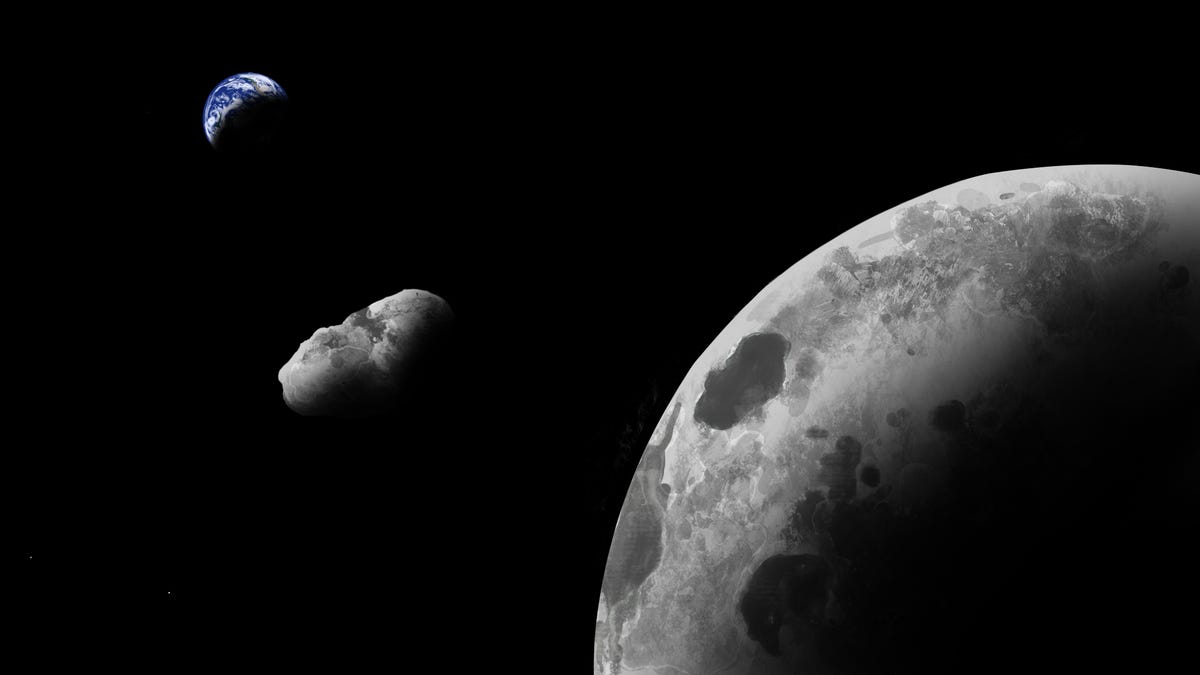A lost piece of the moon has been discovered orbiting the Earth and sun
Scientists think the "quasi-satellite" may have been blasted off the lunar surface.

An artist's impression of Earth quasi-satellite Kamo`oalewa near the Earth-moon system. Astronomers using the Large Binocular Telescope have shown that it might be a lost fragment of the moon.
Every April, for a fleeting few weeks, the faint glow of a near-Earth asteroid curiously shimmers on scientists' telescopes. Religiously catching the annual event, a group of astronomers pieced together a surprising revelation about the little shard: It doesn't appear to be any old space rock. It looks like a broken piece of the moon.
The Ferris wheel-sized chip goes by the Hawaiian name of Kamo`oalewa, and evidence for its lunar identity was published Thursday in the journal Nature Communications Earth & Environment.
"I looked through every near-Earth asteroid spectrum we had access to, and nothing matched," Ben Sharkey, a graduate student in the department of planetary sciences at the University of Arizona and the paper's lead author, said in a statement.
Instead, Sharkey and fellow researchers realized that the rock had a pattern of reflected light, or spectrum, very closely related to moon rocks brought back from NASA's Apollo missions.
"These challenging observations were enabled by the immense light gathering power of the twin 8.4-meter (27.5 feet) telescopes of the Large Binocular Telescope," Al Conrad, a staff scientist at the Large Binocular Telescope Observatory and co-author of the study, said in a statement.
But that's not the only proof of Kamo`oalewa's lunar origins. The quasi-satellite -- a subcategory of near-Earth asteroids that orbit both the sun and the Earth -- travels around our planet with an unusual tilt, which is why it only shows up in the night sky once yearly.
"It is very unlikely that a garden-variety near-Earth asteroid would spontaneously move into a quasi-satellite orbit like Kamo`oalewa's,'' Renu Malhotra, a professor of planetary sciences at the University of Arizona, said in a statement.
She notes that the fragment won't remain in this particular orbit for very long. Estimating that it arrived in its current position 500 years ago, Malhotra believes its trajectory will change in about 300 years.
However, even with such powerful machinery and detailed orbital analysis, the team traversed a long road to unlock Kamo`oalewa's secret. Because of the dim orb's infrequent emergence, they had to construct their data sets over the course of several years to paint a full picture of the extraterrestrial object -- and find enough proof to confirm its lunar beginnings.
"We doubted ourselves to death," Vishnu Reddy, co-author of the study from the Lunar and Planetary laboratory at the University of Arizona, said in a statement.
The project began in 2016 and ran a few years, but in 2020 the team missed the asteroid's appearance window due to COVID-19 restrictions. Now, in 2021, they finally feel comfortable with the amount of information they've gathered to announce Kamo`oalewa's unique past. Said Sharkey, "This spring, we got much needed follow-up observations and went, 'Wow it is real.' It's easier to explain with the moon than other ideas."
There's just one unanswered question: How did Kamo`oalewa break off the moon?
As this is the first near-Earth asteroid to indicate lunar properties, it's still unclear whether the space rock is an anomaly or if there are other moon fragments lurking in the solar system, waiting to be found.

